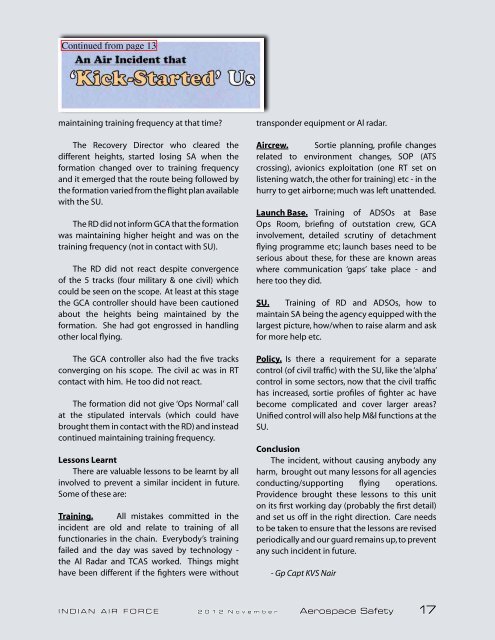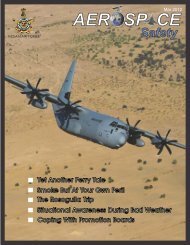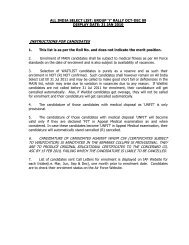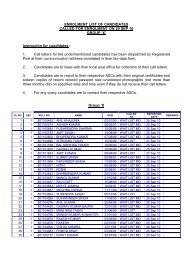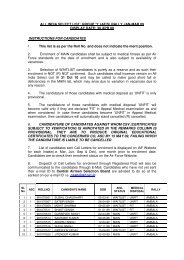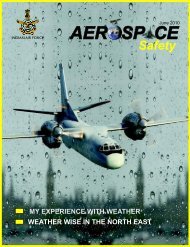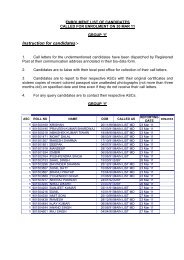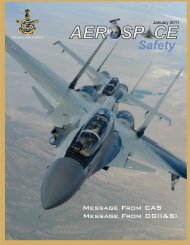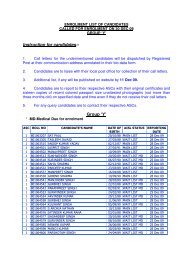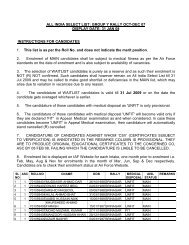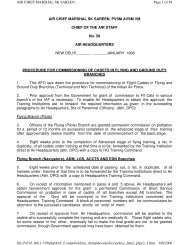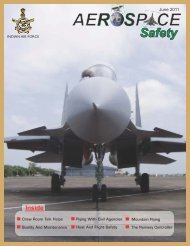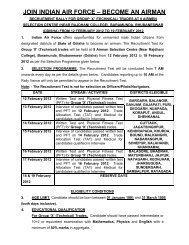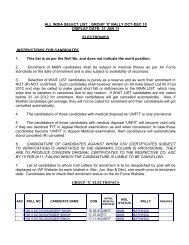November 2012 - Indian Airforce
November 2012 - Indian Airforce
November 2012 - Indian Airforce
You also want an ePaper? Increase the reach of your titles
YUMPU automatically turns print PDFs into web optimized ePapers that Google loves.
Continued from page 13<br />
maintaining training frequency at that time?<br />
The Recovery Director who cleared the<br />
different heights, started losing SA when the<br />
formation changed over to training frequency<br />
and it emerged that the route being followed by<br />
the formation varied from the flight plan available<br />
with the SU.<br />
The RD did not inform GCA that the formation<br />
was maintaining higher height and was on the<br />
training frequency (not in contact with SU).<br />
The RD did not react despite convergence<br />
of the 5 tracks (four military & one civil) which<br />
could be seen on the scope. At least at this stage<br />
the GCA controller should have been cautioned<br />
about the heights being maintained by the<br />
formation. She had got engrossed in handling<br />
other local flying.<br />
The GCA controller also had the five tracks<br />
converging on his scope. The civil ac was in RT<br />
contact with him. He too did not react.<br />
The formation did not give ‘Ops Normal’ call<br />
at the stipulated intervals (which could have<br />
brought them in contact with the RD) and instead<br />
continued maintaining training frequency.<br />
Lessons Learnt<br />
There are valuable lessons to be learnt by all<br />
involved to prevent a similar incident in future.<br />
Some of these are:<br />
Training. All mistakes committed in the<br />
incident are old and relate to training of all<br />
functionaries in the chain. Everybody’s training<br />
failed and the day was saved by technology -<br />
the Al Radar and TCAS worked. Things might<br />
have been different if the fighters were without<br />
transponder equipment or Al radar.<br />
Aircrew. Sortie planning, profile changes<br />
related to environment changes, SOP (ATS<br />
crossing), avionics exploitation (one RT set on<br />
listening watch, the other for training) etc - in the<br />
hurry to get airborne; much was left unattended.<br />
Launch Base. Training of ADSOs at Base<br />
Ops Room, briefing of outstation crew, GCA<br />
involvement, detailed scrutiny of detachment<br />
flying programme etc; launch bases need to be<br />
serious about these, for these are known areas<br />
where communication ‘gaps’ take place - and<br />
here too they did.<br />
SU. Training of RD and ADSOs, how to<br />
maintain SA being the agency equipped with the<br />
largest picture, how/when to raise alarm and ask<br />
for more help etc.<br />
Policy. Is there a requirement for a separate<br />
control (of civil traffic) with the SU, like the ‘alpha’<br />
control in some sectors, now that the civil traffic<br />
has increased, sortie profiles of fighter ac have<br />
become complicated and cover larger areas?<br />
Unified control will also help M&l functions at the<br />
SU.<br />
Conclusion<br />
The incident, without causing anybody any<br />
harm, brought out many lessons for all agencies<br />
conducting/supporting flying operations.<br />
Providence brought these lessons to this unit<br />
on its first working day (probably the first detail)<br />
and set us off in the right direction. Care needs<br />
to be taken to ensure that the lessons are revised<br />
periodically and our guard remains up, to prevent<br />
any such incident in future.<br />
- Gp Capt KVS Nair<br />
INDIAN AIR FORCE 2 0 1 2 N o v e m b e r Aerospace Safety 17


